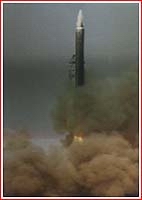Strela

Strela was a Russian space launch vehicle converted from the RS-18 intercontinental ballistic missile (NATO classification: SS-19 Stiletto) by NPO Mashinostoyeniya and marketed by Space Development Corp. Strela ("arrow") is 26.7 meters long with a takeoff mass of 104 tons and can carry a payload of up to 1,700 kilograms into low Earth orbit.
With production of Cosmos-3M rockets halted in 1995, Russian agencies have few choices, other than converted RS-18s and RSD-10Ms, like Strela, Start, and Rockot. Of Russia's 160 nuclear warhead-bearing RS-18s, 55 must be decommissioned by 2007 under the START 2 treaty. The RS-18 has logged 146 launches over the past 27 years, with 143 of them a complete success.
Similar in performance to Rockot, Strela can be launched from Baikonur or Svobodny (Russia's newest spaceport, a converted facility that used to serve as the base for a military ballistic missile unit), while Rockot is launched from Plesetsk and may in the future be launched from Baikonur. Although in terms of payload mass Strela is slightly inferior to Rockot, it has a lower orbital injection cost. Strela can put satellites into orbits with an inclination of 63° from Baikonur and into orbits with inclinations in the range 52 to 61 and 90 to 104° from Svobodny. The first demonstration launch took place on 5 December 2003 from Baikonur.
Strela is also a series of Russian military, store-dump communications satellites, the
first of which was launch in 1964. The latest batch of six Strela-3 satellites
was placed in highly inclined 1,400-kilometers-high orbits by a Tsyklon rocket on
28 December 2001.


